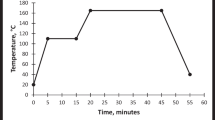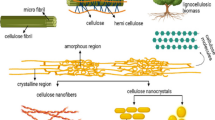Abstract
New hybrid metal organic framework based polymer nanocomposite (ZIF-8/NC-PU) and interpenetrating polymer gel nanocomposites (NC-PU) were prepared for the adsorption of cationic (Rh-B) and anionic (IC) dyes from aqueous solution. The characterisation of the ZIF-8 based composites and gel composites is carried out using FT-IR and SEM analysis to investigate the chemical composition and morphology of the sample. Moringa oleifera seed pod based nanocellulose (5 wt%) is used as the filler in NC-PU gel composites and ZIF-8/NC-PU MOF composites. The optimal level of the most significant identified variables affecting the adsorption process were determined by the response surface methodology (RSM) using Plackett–Burman and Box–Behnken design. Adsorption capacity increased with the increase in dosage of the adsorbent, pH and initial dye concentration. Plackett–Burman was performed for the experiments involving the dyes Rh-B and Indigo carmine dyes. It gave 12 experiments in each trials and resulted in 3 significant parameters. Box–Behnken was further used to determine the optimum parameters for the adsorption keeping PU weight percentage as 3. The percentage uptake predicted by the model is in good agreement with the experimental values. The findings assume that the adsorbents could be used effectively as highly efficient adsorbents for the removal of multiple dyes from wastewater.
Graphical Abstract















Similar content being viewed by others
References
M.T. Yagub, T.K. Sen, S. Afroze, H.M. Ang, Dye and its removal from aqueous solution by adsorption: a review. Adv. Colloid Interface Sci. 209, 172–184 (2014)
Y. Zhou, J. Lu, Y. Zhou, Y. Liu, Recent advances for dyes removal using novel adsorbents: a review. Environ. Pollut. 252, 352–365 (2019)
A.A. Adeyemo, I.O. Adeoye, O.S. Bello, Adsorption of dyes using different types of clay: a review. Appl. Water Sci. 7, 543–568 (2017)
A. Saifi, J.P. Joseph, A.P. Singh, A. Pal, K. Kumar, Complexation of an azo dye by cyclodextrins: a potential strategy for water purification. ACS Omega 6(7), 4776–4782 (2021)
G. Crini, E. Lichtfouse, Advantages and disadvantages of techniques used for wastewater treatment. Environ. Chem. Lett. 17, 145–155 (2019)
A.M. Deegan, B. Shaik, K. Nolan, K. Urell, M. Oelgemöller, J. Tobin, A. Morrissey, Treatment options for wastewater effluents from pharmaceutical companies. Int. J. Environ. Sci. Technol. 8, 649–666 (2011)
N.K. Srivastava, C.B. Majumder, Novel biofiltration methods for the treatment of heavy metals from industrial wastewater. J. Hazard. Mater. 151(1), 1–8 (2008)
B.L. Phoon, C.C. Ong, M.S.M. Saheed, P.L. Show, J.S. Chang, T.C. Ling, J.C. Juan, Conventional and emerging technologies for removal of antibiotics from wastewater. J. Hazard. Mater. 400, 122961 (2020)
M. Clara, B. Strenn, O. Gans, E. Martinez, N. Kreuzinger, H. Kroiss, Removal of selected pharmaceuticals, fragrances and endocrine disrupting compounds in a membrane bioreactor and conventional wastewater treatment plants. Water Res. 39(19), 4797–4807 (2005)
P.E. Stackelberg, E.T. Furlong, M.T. Meyer, S.D. Zaugg, A.K. Henderson, D.B. Reissman, Persistence of pharmaceutical compounds and other organic wastewater contaminants in a conventional drinking-water-treatment plant. Sci. Total Environ. 329(1–3), 99–113 (2004)
E. Jamróz, P. Kulawik, P. Kopel, The effect of nanofillers on the functional properties of biopolymer-based films: a review. Polymers 11(4), 675 (2019)
R.A. Ilyas, A. Azmi, N.M. Nurazzi, A. Atiqah, M.S.N. Atikah, R. Ibrahim, S.M. Sapuan, Oxygen permeability properties of nanocellulose reinforced biopolymer nanocomposites. Mater. Today: Proc. 52, 2414–2419 (2022)
R. Paradelo, X. Vecino, A.B. Moldes, M.T. Barral, Potential use of composts and vermicomposts as low-cost adsorbents for dye removal: an overlooked application. Environ. Sci. Pollut. Res. 26, 21085–21097 (2019)
C. Petit, T.J. Bandosz, MOF–graphite oxide nanocomposites: surface characterization and evaluation as adsorbents of ammonia. J. Mater. Chem. 19(36), 6521–6528 (2009)
S.I. Asiya, G.Z. Kyzas, K. Pal, F.G. de Souza Jr, Graphene functionalized hybrid nanomaterials for industrial-scale applications: a systematic review. J. Mol. Struct. 1239, 130518 (2021)
J. Kaur, I. Sharma, E. Zangrando, K. Pal, S.K. Mehta, R. Kataria, Fabrication of novel copper MOF nanoparticles for nanozymatic detection of mercury ions. J. Mater. Res. Technol. 22, 278–291 (2023)
K. Pal, N. Asthana, A.A. Aljabali, S.K. Bhardwaj, S. Kralj, A. Penkova, S. Thomas, T. Zaheer, F. Gomes de Souza, A critical review on multifunctional smart materials ‘nanographene’ emerging avenue: nano-imaging and biosensor applications. Crit. Rev. Solid State Mater. Sci. 47(5), 691–707 (2022)
K. Pal, S. Chakroborty, P. Panda, N. Nath, S. Soren, Environmental assessment of wastewater management via hybrid nanocomposite matrix implications—an organized review. Environ. Sci. Pollut. Res. 29(51), 76626–76643 (2022)
F. Yang, M. Du, K. Yin, Z. Qiu, J. Zhao, C. Liu, G. Zhang, Y. Gao, H. Pang, Applications of metal-organic frameworks in water treatment: a review. Small 18(11), 2105715 (2022)
K. Maru, S. Kalla, R. Jangir, Dye contaminated wastewater treatment through metal–organic framework (MOF) based materials. New J. Chem. 46(7), 3054–3072 (2022)
J.Y. Lee, Q. She, F. Huo, C.Y. Tang, Metal–organic framework-based porous matrix membranes for improving mass transfer in forward osmosis membranes. J. Membr. Sci. 492, 392–399 (2015)
Z.K. Tan, J.L. Gong, S.Y. Fang, J. Li, W.C. Cao, Z.P. Chen, Outstanding anti-bacterial thin-film composite membrane prepared by incorporating silver-based metal–organic framework (Ag-MOF) for water treatment. Appl. Surf. Sci. 590, 153059 (2022)
T. Wu, N. Prasetya, K. Li, Recent advances in aluminium-based metal–organic frameworks (MOF) and its membrane applications. J. Membr. Sci. 615, 118493 (2020)
D. Yamamoto, T. Maki, S. Watanabe, H. Tanaka, M.T. Miyahara, K. Mae, Synthesis and adsorption properties of ZIF-8 nanoparticles using a micromixer. Chem. Eng. J. 227, 145–150 (2013)
J.G. Vijayan, A. Chandrashekar, J. AG, T.N. Prabhu, P. Kalappa, Polyurethane and its composites derived from bio-sources: synthesis, characterization and adsorption studies. Polym. Polym. Compos. (2022). https://doi.org/10.1177/09673911221110347
R. Venkataraghavan, R. Thiruchelvi, D. Sharmila, Statistical optimization of textile dye effluent adsorption by Gracilaria edulis using Plackett–Burman design and response surface methodology. Heliyon 6(10), e05219 (2020)
J.G. Vijayan, T.N. Prabhu, K. Pal, Poly(N-isopropyl acrylamide)-co-poly(sodium acrylate) hydrogel for the adsorption of cationic dyes from aqueous solution. Eur. Phys. J. E 46(3), 11 (2023)
A. Mandal, D. Chakrabarty, Isolation of nanocellulose from waste sugarcane bagasse (SCB) and its characterization. Carbohydr. Polym. 86(3), 1291–1299 (2011)
S. Zhang, F. Zhang, L. Jin, B. Liu, Y. Mao, Y. Liu, J. Huang, Preparation of spherical nanocellulose from waste paper by aqueous NaOH/thiourea. Cellulose 26, 5177–5185 (2019)
M. Pühse, M. Keerl, C. Scherzinger, W. Richtering, R. Winter, Influence of pressure on the state of poly(N-isopropylacrylamide) and poly(N,N-diethylacrylamide) derived polymers in aqueous solution as probed by FTIR-spectroscopy. Polymer 51(16), 3653–3659 (2010)
G. Gürdağ, B. Kurtulus, Synthesis and characterization of novel poly(N-isopropylacrylamide-co-N,N′-dimethylaminoethyl methacrylate sulfate) hydrogels. Ind. Eng. Chem. Res. 49(24), 12675–12684 (2010)
M. Khajavian, E. Salehi, V. Vatanpour, Nanofiltration of dye solution using chitosan/poly(vinyl alcohol)/ZIF-8 thin film composite adsorptive membranes with PVDF membrane beneath as support. Carbohydr. Polym. 247, 116693 (2020)
H. Yang, X. Guo, R. Chen, Q. Liu, J. Liu, J. Yu, M. Zhang, Enhanced anti-biofouling ability of polyurethane anti-cavitation coating with ZIF-8: a comparative study of various sizes of ZIF-8 on coating. Eur. Polym. J. 144, 110212 (2021)
N. Yasmeen, A. Karpinska, J. Kalecki, W. Kutner, K. Kwapiszewska, P.S. Sharma, Electrochemically synthesized polyacrylamide gel and core–shell nanoparticles for 3D cell culture formation. ACS Appl. Mater. Interfaces 14(29), 32836–32844 (2022)
Q. Yu, X. Jiang, Z. Cheng, Y. Liao, M. Duan, Porous ZIF-8@ polyacrylonitrile composite beads for iodine capture. RSC Adv. 11(48), 30259–30269 (2021)
H. Li, D. Meng, P. Qi, J. Sun, H. Li, X. Gu, S. Zhang, Fabrication of a hybrid from metal organic framework and sepiolite (ZIF-8@ SEP) for reducing the fire hazards in thermoplastic polyurethane. Appl. Clay Sci. 216, 106376 (2022)
S.C. Ferreira, R.E. Bruns, H.S. Ferreira, G.D. Matos, J.M. David, G.C. Brandão, W.N.L. Dos Santos, Box–Behnken design: an alternative for the optimization of analytical methods. Anal. Chim. Acta 597(2), 179–186 (2007)
J.P. Maran, S. Manikandan, K. Thirugnanasambandham, C.V. Nivetha, R. Dinesh, Box–Behnken design based statistical modeling for ultrasound-assisted extraction of corn silk polysaccharide. Carbohydr. Polym. 92(1), 604–611 (2013)
P. Tripathi, V.C. Srivastava, A. Kumar, Optimization of an azo dye batch adsorption parameters using Box–Behnken design. Desalination 249(3), 1273–1279 (2009)
Funding
This study is self supported. No external funding is received to conduct the study.
Author information
Authors and Affiliations
Contributions
JGV contributed in the synthesis and applications, TNP (Professor) contributed in the research plan, JAG contributed in planning and conceptualization of the manuscript. SC provides research resources and guidance of the research direction, as well as made substantial contributions to conception and moderation. ISF contributed plan of the work in ensuring analysis and revising it critically for important intellectual content. All the authors have accepted responsibility for the entire content of this submitted manuscript and approved submission.
Corresponding author
Ethics declarations
Competing Interests
The authors declare no competing interests.
Additional information
Publisher's Note
Springer Nature remains neutral with regard to jurisdictional claims in published maps and institutional affiliations.
Rights and permissions
Springer Nature or its licensor (e.g. a society or other partner) holds exclusive rights to this article under a publishing agreement with the author(s) or other rightsholder(s); author self-archiving of the accepted manuscript version of this article is solely governed by the terms of such publishing agreement and applicable law.
About this article
Cite this article
Vijayan, J.G., Prabhu, T.N., Jineesh, A.G. et al. NEW Hybrid ZIF-8/NC-PU and NC-PU Gel Composites for the Effective Removal of Cationic and Anionic Dye from Aqueous Solution: Process Optimization. J Inorg Organomet Polym 33, 3861–3881 (2023). https://doi.org/10.1007/s10904-023-02700-1
Received:
Accepted:
Published:
Issue Date:
DOI: https://doi.org/10.1007/s10904-023-02700-1




